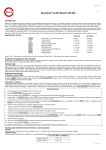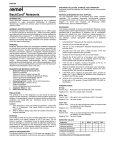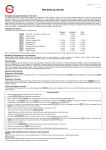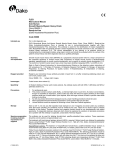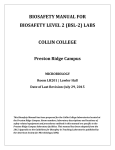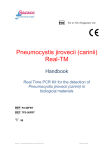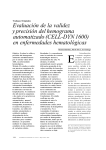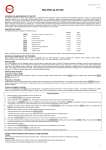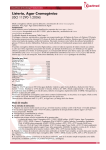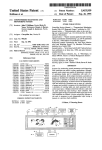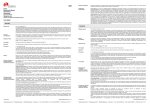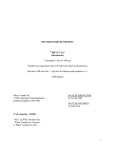Download LP2 - Cellabs
Transcript
Français English FIGURE 1: PNEUMO CEL INDIRECT DIAGRAM FOR USE PNEUMO CEL INDIRECT IF TEST Prepare specimen slide Add 25µL of RP2 to specimen slide INTENDED USE Incubate for 30 minutes at 37OC The Pneumo Cel Indirect IF Test is an invitro indirect Immunofluorescence test for the detection of Pneumocystis carinii (P.jirovecii) in human specimens. INTRODUCTION Wash for 1 minute in PBS and remove excess moisture from slide P.carinii(P.jirovecii) (PC) is an extracellular eukaryotic organism shown to be related to the fungi (1). It is an opportunistic pathogen causing interstitial pneumonia in immunosuppressed hosts, such as premature infants, children with congenital immunodeficiencies and organ transplant recipients (2,3,4). With the advent of the acquired immunodeficiency syndrome (AIDS), P. carini (P.jirovecii)i pneumonia (PCP) has emerged as the most common life-threatening opportunistic infection in these patients. PCP occurs in over 75% of AIDS patients (5,6,7) and is usually associated with diminished CD4+ cells (8). PC is generally confined to the lungs, although there have been recent reports of disseminated extrapulmonary disease (9) which may be as a result of the common use of aerosolised pentamidine (10). Add 25µL of RM to specimen slide Incubate for 30 minutes at 37OC The most common form of PC is the thick-walled cyst (5-8mm) containing up to 8 intracystic bodies (sporozoites, 1-2mm). These mature into extracystic pleomorphic forms, the trophozoites (2-5mm). The development cycle occurs in both the alveolar epithelial cells and in the alveolar spaces. Wash for 1 minute in PBS and remove excess moisture from slide PRINCIPLE OF THE TEST PC may be identified by a variety of histochemical stains such as methenamine silver, Giemsa and toluidine blue (11). The stains can, however, be difficult to perform, they are non-specific and they may not detect all stages of the life cycle of the organism. Experience is also required for interpretation. More recently, immunofluorescence assays (IFA) using monoclonal antibodies to PC have been developed. These techniques are rapid, easy to perform and specimens from induced sputum and bronchoalveolar lavage can be used, thus avoiding the need for more invasive procedures such as lung and transbronchial biopsies. IFA has been shown to be both specific and sensitive (12,13), and also more sensitive than histochemical staining (14). Add drop of RMF and cover Scan at X400 – X1000 TABLE 1: Trial SENSITIVITY, SPECIFICITY, & OTHER DATA ON THE PNEUMO INDIRECT CEL Sensitivity Specificity Repeatability The PNEUMO-CEL INDIRECT IF TEST is an indirect immuno-fluorescence test for PC organisms in methanol-fixed specimens. The fluorescein-labelled mouse monoclonal antibodies bind specifically to the murine raised monoclonal, initially bound to the organisms. Washing steps, following both the monoclonal and fluorescein conjugated antibodies, removes any unbound antibody. When viewed under a fluorescence microscope, PC are seen as bright , apple green bodies which may be present singularly or in cluster. Trophozoites, cysts and the extra cellular matrix , which binds cysts, are stained. Reproducibility CONTENTS OF THE KIT A 100% 100% - - B C 100% 100% 100% 100% - - D 100% 95.1% - - E - - 100% Correlation 100% Correlation Consult Instructions for Use V l Temperature Limitation g Batch 8: 2: ab H D Cellabs Pty Ltd Unit 7, 27 Dale Street (PO Box 421) Brookvale, NSW 2100 Australia WMDE Bergerweg 18 6085 AT Horn The Netherlands Use By/Expiration Date Insert Version Do Not Re-use C 1.25mL 5mL Mounting Fluid 2.5mL 2 x 2.5mL 50 200 Materials are supplied ready for use. Store at 2-8oC.Expiry dates are clearly marked on each kit component and on the box. Expiry dates do not change once opened. MATERIALS REQUIRED BUT NOT PROVIDED Positive control human PC; microscope slides with 6-8mm diameter wells; precision pipette for delivering 25mL; methanol for specimen fixation; humid chamber; wash bath; phosphate buffered saline (PBS) for washing step; cover slips; non-fluorescing immersion oil; and fluorescence microscope with filter system for FITC (maximum excitation wavelength 490nm, mean emission wavelength 530nm) and x400-x1000 magnification. PREPARATION OF SLIDES Apply 25µL to 1 well (0.8cm) slide and air dry. Fix slide for 5 minutes in acetone. If slides are not stained immediately they may be stored below 0oC for several weeks. INSTRUCTIONS FOR USE 1. Add 25µL of RP2 monoclonal reagent to the fixed test and control slide, covering well area. 2. Incubate the slides in the dark at 37oC in a humid chamber for 30 minutes. Do no allow slides to dry out. 3. Wash the slides gently in PBS bath, drain the slides and remove excess moisture until just dry. 4. Add 25µL of the anti-mouse Ig FITC reagent RMto the specimen. Incubate slides in the dark as in step 2. 5. Wash the slides gently in PBS bath, drain the slides and remove excess moisture until just dry 6. Add a drop of RMF to the slide well. Place a coverslip on top of the drop and remove air bubbles. 7. Scan the entire specimen using a fluorescence microscope initially at X400 magnification, then at X1000 for confirmation. Read immediately or store at 2-8oC in the dark for up to 24 hours. READING AND INTERPRETATION OF RESULTS AND DIAGNOSIS 1. PC should exhibit bright, apple-green fluorescence of the round, thick-walled cysts and pleomorphic trophozoites in contrast to the reddish-brown colour of counterstained material. The organisms occur either singularly or more commonly in clusters in an extracellular matrix, which is also stained. A test is considered positive if two or more cysts are present. 3. Negative specimens should not display fluorescent organisms of characteristic morphology. 4. Fluorescent material which is not apple green and can be distinguished from typical PC forms should be disregarded. WASTE DISPOSAL Dispose of any unused components as biohazardous waste. Where the test reagent has been disposed of in the sink, ensure it is flushed with large quantities of water (as the sodium azide it contains may react with copper/lead plumbing systems). For more information, please refer to the MSDS. en fr de it es pt 1 Anti Mouse FITC Reagent RMF SPECIMEN COLLECTION Clinical specimens should be processed as soon as possible after collection. Induced sputum, bronchial wash, bronchoalveolar lavage and tissue impression smears may be used. The presence of mucous in specimen may prevent adequate staining. Work in a biohazard hood. A positive control slide should be included with each series of test specimens. Preparation of Induced Sputum Specimens Prepare 0.3% dithiothreitol (DTT) in distilled water. Mix equal volumes of sputum and DTT solution. Mix vigorously (vortex) to dispense clumps. Incubate for 30 minutes at 37oC. Centrifuge for 5 minutes at 1500g. Decant supernatant. Resuspend pellet in 0.2-0.5mL of PBS and mix vigorously. Preparation of Bronchial Wash and Bronchoalveolar Lavage Specimens Centrifuge the specimen at 1500g for 10 minutes. Remove the supernatant leaving 0.5mL. Decant supernatant. Resuspend pellet in 0.2-0.5mL of PBS and mix vigorously Tel: +61 2 9905 0133 Fax: +61 2 9905 6426 Web: http://www.cellabs.com.au Email: [email protected] Control Positive RM PRECAUTIONS For in vitro diagnostic use only. Do not use after the expiry date shown on the label. If protective packaging is damaged, contact your local distributor and ask for a replacement. Do not mix reagents from different kits. The Pneumo Cel Reagent has been optimised for use with Cellabs Mounting Fluid. Evans Blue dye contained in the test reagent is a possible carcinogen, therefore avoid contact with the skin. Patient specimens and the positive control slide should be handled as though potentially infectious. A Positive Control Slide must be run with each test run. Refer to Material Safety Data Sheet (MSDS) for further information. EXPLANATION OF SYMBOLS In Vitro Diagnostic Medical Device Bulk 5mL Monoclonal Antibody Reagent Tests Not cross reactive with Cryptococcus neoformans, Candida tropicalis, Saccharomyces cerevesiae, Aspergillus niger, Candida krusei, Candida albicans i KP2 Standard 1.25mL RP2 LP2.3 10 December 2013 0843 SENSITIVITY, SPECIFICITY, & OTHER DATA ON THE PNEUMO CEL Refer to summary table at end of insert. All data on the Pneumo Cel can be obtained in the product information sheet. Please ask your local distributor or contact Cellabs. INDEMNITY NOTICE Modifications or changes made in the recommended procedure may affect the stated or implied claims. A positive or negative result does not preclude the presence of other underlying causative agents. Cellabs and its agents and distributors shall not be liable for damages under these circumstances. 4/4 en fr de it es pt LP2.3 1/4 en fr de it es pt LP2.3 Français PNEUMO CEL INDIRECT PRINCIPE DU TEST ET INDICATIONS D’EMPLOI Le coffret Pneumo Cel IF est un test in vitro par immunofluorescence directe conçu pour détecter et diagnostiquer la présence de Pneumocystis carinii dans les échantillons humains. L’anticorps monoclonal de souris marqué à la fluorescéine se lie spécifiquement aux P. carinii de l’échantillon. P. carinii fluorescent d’un vert intense et démontrent leur morphologie typique. COMPOSITION DU COFFRET RP2 Réactif Pneumo Cel RM Anti Mouse FITC Reagent RMF Liquide de Montage KP1 Standard 1.25mL Bulk 5mL 1.25 mL 5mL 2.5mL 2 X 2.5mL 50 200 Déterminations o Conserver à 2-8 C. Les dates de péremption sont clairement indiquées sur chaque composant et sur l’étiquette du coffret, et ne sont pas affectées par l’ouverture du coffret. MATERIELS REQUIS NON FOURNIS Lames à spots diamètre 6-8 mm; pipette de 25 µL; acétone pour fixation des échantillons; chambre humide; bain de lavage des lames; tampon P.B.S. pour lavage; lamelles couvre objets; huile à immersion non fluorescente; microscope à fluorescence pour FITC (490/530 nm), grossissement 400 à 1000. PRECAUTIONS Produit à usage uniquement in vitro. Ne pas utiliser après la date de péremption indiquée sur l’étiquette. Si l’emballage est abîmé, contactez votre fournisseur local pour un remplacement. Ne pas mélanger les composants de coffrets différents. Pneumo Cel est optimisé pour l’emploi des lames de contrôle et du liquide de montage fournis par Cellabs. Le Bleu d’Evans contenu dans le réactif est un carcinogène potentiel, donc évitez tout contact avec la peau. Les lames de contrôle positives ainsi que les échantillons patients doivent être considérés comme potentiellement infectieux. Une Lame de Contrôle Positive doit être préparée pour chaque série de tests afin d’en vérifier la qualité. Consultez la fiche de sécurité du produit (notice MSDS) pour plus amples informations. COLLECTION DES ECHANTILLONS Les spécimens cliniques doivent être analysés dès que possible après leur prélèvement. On peut utiliser du sputum induit, du lavage bronchial ou broncho alvéolaire ou des impressions de tissu sur lame. La présence de mucus dans l’échantillon peut empêcher une coloration adéquate. Travaillez sous hotte à flux laminaire. Une lame de contrôle doit être incluse avec chaque série de spécimens à analyser. Préparation de spécimens de sputum induit Préparer une solution à 0.3% de DTT (dithiothreitol) à l’eau distillée. Mélanger sputum et solution DTT à volume égal. Mélanger vigoureusement (vortex) pour émulsionner la solution. Incuber 30 minutes à 37oC. Centrifuger 5 minutes à 1500g. Décanter le surnageant. Suspendre le culot dans 0.2-0.5 mL de P.B.S. et mélanger vigoureusement. Préparation de spécimens de lavage bronchial ou broncho alvéolaire Images of human Pneumocystis carinii stained with Pneumo Cel Indirect IFA. Centrifuger le spécimen 10 minutes à 1500g. Jeter le surnageant, en en laissant 0.5 mL. Décanter le surnageant restant. Suspendre le culot dans 0.2-0.5 ml de P.B.S. et mélanger vigoureusement. PREPARATION DES LAMES Déposer 25 µL sur le spot (8 mm) d’une lame microscopique et laisser sécher à l’air. Fixer à l’acétone pendant 5 minutes. Si la lame n’est pas traitée immédiatement, elle peut être conservée à 0oC pendant plusieurs semaines. MODE D’EMPLOI 1. Déposez 25 µL de RP2 sur le spot de la lame de ab ou sur le spot de lame de l’échantillon patient fixé. 2. 3. 4. 5. 6. 7. 8. Incubez les lames à 37oC en chambre humide pour 30 minutes. Ne laissez pas les lames sécher, car cela accroît le risque de marquages non spécifiques. Rincez les lames délicatement dans un bain de P.B.S. pendant 1 minute. Egouttez les lames afin d’éliminer tout liquide excessif jusqu'à ce qu’elles soient sèches. Déposez 25 µL de RM sur le spot de la lame de ab ou sur le spot de lame de l’échantillon patient fixé. Incubez les lames à 37oC en chambre humide pour 30 minutes. Ne laissez pas les lames sécher, car cela accroît le risque de marquages non spécifiques. Rincez les lames délicatement dans un bain de P.B.S. pendant 1 minute. Egouttez les lames afin d’éliminer tout liquide excessif jusqu'à ce qu’elles soient sèches. Déposez une goutte de RMF sur chaque spot. Placez la lamelle en évitant les bulles. Observez le spécimen au microscope à fluorescence sous huile à immersion, initialement à x400, puis à x1000 pour confirmation. Si l’observation est retardée, conservez les lames à l’obscurité à 2-8oC jusqu'à 24 heures. OBSERVATION, INTERPRETATION DES RESULTATS ET DIAGNOSTIQUE A l’inverse de la coloration de fond brun rougeâtre, les trophozoites pleomorphes de Pneumocystis carinii (PC) présentent une intense fluorescence vert pomme, alors que les cystes á paroi épaisse présentent une fluorescence en halo autour de leur périphérie. Les organismes peuvent être seuls ou plus fréquemment en grappes incluses dans une membrane extracellulaire, aussi colorée. Lorsque vous observez au moins deux cystes, le résultat est positif. Utilisez la lame de contrôle à titre de comparaison pour vérifier l’apparence et la taille des organismes. Le résultat est négatif quand aucun organisme fluorescent de morphologie caractéristique n’est observable. Ignorez tout élément fluorescent qui n‘est pas vert pomme et qui se distingue de la forme typique de P. carinii. DECHETS Jetez tout composant inutilisé dans la poubelle aux déchets biologiques. Lorsque vous videz le réactif du coffret dans l’évier, assurez-vous dans le diluer avec une large quantité d’eau courante, car l’azide de sodium qu’il contient peut être explosif en contact avec les égouts en cuivre ou en plomb. Consultez la fiche de sécurité du produit (notice MSDS) pour plus amples informations. SENSIBILITÉ, SPÉCIFICITÉ ET AUTRES DONNEES DU TEST PNEUMO CEL Referez-vous au tableau récapitulatif en fin de notice. Toutes les données sur le test Pneumo Cel sont sur la fiche technique du produit. Contactez Cellabs ou votre distributeur pour l’obtenir. NOTICE D’INDEMNITE Toute modification ou variation du protocole d’emploi recommandé peut affecter les performances annoncées du produit. Un résultat positif ou négatif n’exclue pas la présence d’autres agents causatifs sous-jacents. Cellabs et ses agents et distributeurs ne sont légalement responsables d’aucun dommage dans de telles circonstances. 2/4 en fr de it es pt LP2.3 REFERENCES 1. Edman,J.C., Kovacs, J..A, Masur, H, Santi, D.V., Elwood, H.J., Sogin, M.L. (1988). Ribosomal RNA sequence shows Pneumocystis carinii to be a member of the fungi. Nature, 334:519-22. 2. Walzer, P.D., Schultz, M.G., Western, K..A., Robbins, J.B. (1976). Pneumocystis carinii pneumonia and primary immune deficiency diseases. Nat,. Cancer Inst. Monogr. 43:65-72. 3. Gryzan, S., Paradis, I.L., Zeevi, A, Duquesnoy, J., Dummer, S., Griffith, B.P., Hardesty, R.L., Trento, A., Nalesnik, M.A., Dauber, J.H., (1988). Unexpectedly high incidence of Pneumocystis carinii infection after lung heart transplantation. Am. Rev. Respir. Dis. 137:1268-1274. 4. Hardy, A.M., Wajszczuk, C.P., Suffrendini, A.F., Hakala, T.R., Ho, M., (1984). Pneumocystis carinii Pneumonia in renal transplant recipients treated with cyclosporine and steroids. J. Infect. Dis. 149:143-147. 5. Hughes, W.T., (1987) Pneumocystis carinii pneumonia. N. Eng. J. Med. 317:1021-3. 6. Kovacs, J..A., Masur, H. (1988). Pneumocystis carinii pneumonia: therapy and prophylaxis. J.Infect. Dis. 158:254-9. 7. Murray, J.F., Garay, S.M., Hopewell, P.C., Mills, J., Snider, G.L, Stover, D.E. (1987). Pulmonary complications of the acquired immunodeficiency syndrome: an update: report of the Second National Heart, Lung and Blood Institute Workshop. Am. Rev.Respir. Dis. 135:504-509. 8. Phair,J., Munoz, A., Detels, R., Kalslow, R., Rinaldo, C., Saarh, A. (1990). The risk of Pneumocystis carinii pneumonia among men infected with the human immunodeficiency virus type 1. New Engl. J. Med. 322:161-165. 9. Pilon, V., Echols, R., Celo, J., Elmendorf, S., (1987). Disseminated Pneumocystis carinii pneumonia infection in AIDS. N. Eng. J. Med. 316: 14101411. 10. Raviglione, M.C. (1990). Extrapulmonary pneumocystosis: the first 50 cases. Rev. Infect. Dis. 12:1127-1138. 11. Ruskin, J. (1986). Newer developments in diagnosis and treatment of Pneumocystis infections. Curr. Clin. Top. Infect. Dis. 7:194-215. 12. Kovacs, J.A., Ng, V.L., Masur, H., Leoung, G., Hadley, W.K., Evans, G., Lane, H.C. Ognibene, F.P., Shelhamer, J., Parillo, J.E., Gill V.J. (1988). Diagnosis of P. Carinii pneumonia: improved detection in sputum with use of monoclonal antibodies. New Eng. J. Med. 318:589-593. 13. Wolfson, J.S., Waldron, M.A, Sierra, L.S. (1990). Blinded comparison of a direct immunofluorescent monoclonal antibody staining method and a Giemsa staining method for identification of P. Carinii in induced sputum and bronchoalveolar lavage specimens of patients infected with human immunodeficiency virus. J. Clin. Micro. 28:2136-2138. 14. Ng. V.L., Virani, N.A., Chaisson, R.E., Yajko, C.D., Sphar, H.T., Cabrian, K.C., Rollins, N., Charache, P., Krieger, M., Haldey, W.K., Hopewell, P.C. (1990). Rapid detection of Pneumocystis carinii using a direct fluorescent monoclonal antibody stain. J. Clin. Micro. 28:2228-2233. 4/4 en fr de it es pt LP2.3



